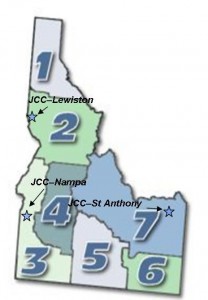 Each state juvenile corrections center (facility) provides medical, educational, cognitive behavioral, residential rehabilitative services, and specialized programs for adjudicated sex offenders, female offenders, juveniles with mental health needs, juveniles with serious chemical dependency needs, and serious juvenile offenders. To the left is a Department district map that shows the locations of each correctional center.
Each state juvenile corrections center (facility) provides medical, educational, cognitive behavioral, residential rehabilitative services, and specialized programs for adjudicated sex offenders, female offenders, juveniles with mental health needs, juveniles with serious chemical dependency needs, and serious juvenile offenders. To the left is a Department district map that shows the locations of each correctional center.
The Juvenile Corrections Act is based on the Balanced Approach and Restorative Justice model. The foundations of the Balanced Approach are Community Safety, Offender Accountability, and Competency Development. Community justice requires that juvenile offenders work to restore the harm caused to their victims and communities to the greatest extent possible. In addition, the balanced approach involves communities in developing the solutions to address juvenile crime. Implementing the Juvenile Corrections Act is an ongoing process that involves not only members of the justice system, but all Idahoans as members of their communities.
For Juveniles Committed to the Department’s Custody
Community safety is addressed by providing secure confinement to offenders deemed a community risk, and by providing juveniles with the opportunity to learn skills to regulate their behavior when they return to the community.
Accountability is promoted through swift and appropriate consequences for actions, taking responsibility for criminal behavior, and providing victim restoration. Juveniles are taught how their crimes affect the community.
Competency development is addressed through education, training in appropriate decision making, social skills development, job skills, etc. These programs require juveniles to examine the thinking patterns associated with their criminal behavior and learn to change them.
Performance-based Standards
Performance-based Standards (PbS) is a set of national standards developed by Council of Juvenile Correctional Administrators (CJCA) based upon the results of the Conditions of Confinement study completed in the mid 1990s. That study identified key areas of institutional operation that, if managed well, would contribute to positive outcomes for juveniles. The standards are organized into nine goal areas:
is a set of national standards developed by Council of Juvenile Correctional Administrators (CJCA) based upon the results of the Conditions of Confinement study completed in the mid 1990s. That study identified key areas of institutional operation that, if managed well, would contribute to positive outcomes for juveniles. The standards are organized into nine goal areas:
- Safety
- Order
- Security
- Health
- Behavioral Health
- Family
- Justice
- Programs
- Reintegration
Idaho Department of Juvenile Corrections’ staff, within the three state facilities and in district offices, collect data for over 100 performance measures twice annually in April and October. That data is then entered into a national website and compiled into graphs and reissued as site reports. Staff at each facility then works closely with the Superintendent and PbS site coordinator to develop a specific Facility Improvement Plan for the following six-month period, until data is collected again. Data is collected from surveys of staff and juveniles, from incident reports, and from reviews of juvenile records. PbS data allows the Department’s Superintendents to review performance in several ways:
- Performance over time
- In comparison to the national average and to the statewide average
- Performance on outcomes targeted for improvement
- Outcomes critical to safe and effective operations
